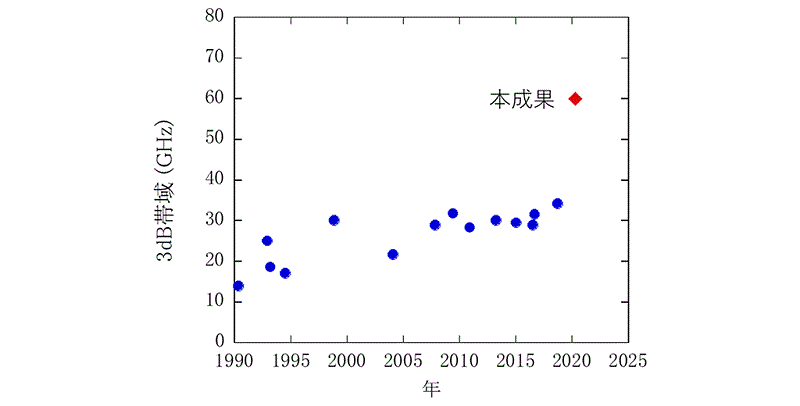
图1:直接调制的激光器的3 dB频带的过渡(不使用其他加速技术)
NTT:开发了100GHz频段,直接调制激光器:SiC,膜激光器
-通过在SiC衬底上的薄膜激光器实现低功耗-
2020/10/20
NTT
东京工业大学
未来工业技术研究所
在具有高导热性的SiC衬底上
使用铟磷化合物半导体
我们已经开发了薄膜激光器。
作为直接调制激光器,3dB频段(* 4)已超过100GHz。
我们已经确认它可以每秒传输256吉比特(2560亿位)的信号,持续2 km。
直接调制激光器:
常规问题:
现在,直接调制激光器已广泛用于数据中心。
但是,调制速度受到限制,这是一个问题。
此解决方案:
如果您使用SiC /薄膜激光器,
未来流量增加
支持低成本和低功耗
它可以应用于NTT的IOWN(*)概念下的大容量光传输板。
发布结果:
这项成就将在英国时间10月19日发布在英国科学杂志“自然光子学”的在线公告版本中。
日本经济新闻
https://www.nikkei.com/article/DGXLRSP542014_Q0A021C2000000/
World’s fastest directly modulated laser exceeding 100-GHz bandwidth
October 20, 2020
World’s fastest directly modulated laser exceeding 100-GHz bandwidth
~Membrane laser on silicon carbide substrate achieves low power consumption
NTT Corporation
Tokyo Institute of Technology
Future Research of Science and Tech,has developed a membrane laser*1 that uses an indium-phosphorus compound semiconductor*2 on a silicon carbide substrate*3 with high thermal conductivity.
This laser,
the world’s first directly modulated laser with a 3-dB bandwidth*4 exceeding 100 GHz, can transmit at 256 gigabits (256 billion bits) per second over a distance of 2 km.
Directly modulated lasers
are now widely used in data centers*5, but their modulation speed is limited, which has been a problem for further increasing in transmission capacity.These results will enable us to respond to
the expected increase in traffic
with a low-cost and
low-power-consumption solution
will contribute to the realization of a high-capacity optical transmission infrastructure that supports NTT’s IOWN*6 concept.
This research
was reported in Nature Photonics on October 19, 2020. NTTPress Releases : NTT HOME
https://www.ntt.co.jp/news2020/2010e/201020a.html
Directly modulated membrane lasers with 108 GHz bandwidth on a high-thermal-conductivity silicon carbide substrate
Abstract
Increasing the modulation speed of semiconductor lasers
has attracted much attention from the viewpoint of both physics and the applications of lasers.
Here we propose a membrane distributed reflector laser on a low-refractive-index and high-thermal-conductivity silicon carbide substrate that overcomes the modulation bandwidth limit.
The laser features a high modulation efficiency because of its large optical confinement in the active region and small differential gain reduction at a high injection current density.
We achieve a 42 GHz relaxation oscillation frequency by using a laser with a 50-μm-long active region.
The cavity, designed to have a short photon lifetime,
suppresses the damping effect while keeping the threshold carrier density low, resulting in a 60 GHz intrinsic 3 dB bandwidth (f3dB).
By employing the photon–photon resonance at 95 GHz due to optical feedback from an integrated output waveguide,
we achieve an f3dB of 108 GHz and demonstrate 256 Gbit s−1 four-level pulse-amplitude modulations with a 475 fJ bit−1 energy cost of the direct-current electrical input.
Nature Photonics